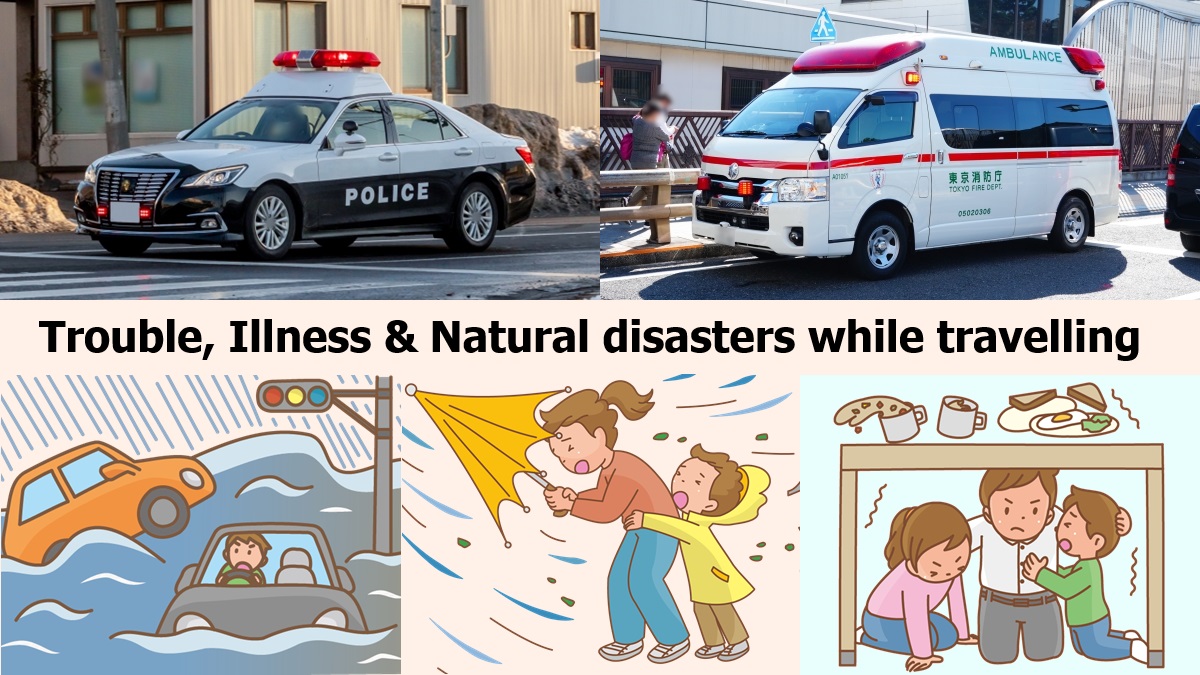Trouble, Illness & Natural disasters while travelling
Japan may be an interesting country for you, but the society, custom and culture differ from your country.
When you travel around Japan, you should mind that enexpected trouble occurs.
Trouble
Illness
Natural disaster
Typhoon
Earthquake & Tsunami
Trouble while travelling
Public safety
It is said that Japan is very safe country.
In fact, Japan is one of the countries of the lowest crime rate in the world.
In Japan, carrying and possessing of guns is banned by the law.
And having and using narcotic drugs and stimulant drugs are also prohibited by law.
There is hardly dangerous town or slum in Japan.
You can walk around Japan safely.
And degree of safety about going out at night is higher than other countries.
But, while travelling, you must pay attention to your belongings in the town.
There is always a chance of purse snatching, stealing luggage, pickpocket, etc. even in Japan.
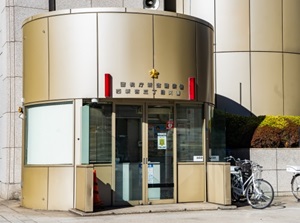
Koban in Shinjuku in Tokyo
If you have dropped your wallet or important things somewhere, you have the possibility to get back it.
Because, if a good person finds it fortunately, the person will bring it to Koban.
Koban is the small police station in any town of Japan.
It is a branch station in the district controlled by the main police station.
A few policemen are always stationed and they sometimes patrol around the district.
It is a small building and a golden pentagonal mark of Japanese police is attached.
On some kobans, there is a sign "KOBAN" for foreign people.
It is said that Koban system reduces the crime rate.
If you have trouble, visit the nearest Koban first.
Losing your belongings, losing your child, asking the way to a destination, etc. are OK.
In addition, if you have had a traffic accident or gotten caught up in a theft and an injury case, call the police at once.
The telephone number of police is "110".
And, if you have found a fire, call the fire engine at once.
The telephone number of fire station is "119".
Language
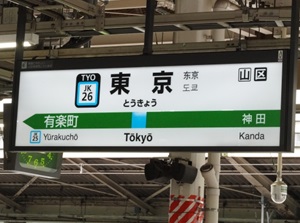
Station-name signboard of Tokyo station
Japanese people speak Japanese.
And Japanese is spoken only in Japan in the world.
There are Korea, Taiwan and China around Japan, and the face and the body type are similar to each other.
But, Japanese language is different from the languages of the countries.
Japanese is an isolated language.
All Japanese people learn English as a useful foreign language at school, but not many people can speak English fluently.
Because the structure of Japanese language is very different from English, it is a little difficult for most Japanese people to make suitable English sentence instantly.
So, many foreign tourists say that they had been troubled about communication with Japanese people.
That is something that cannot be helped.
Rather, we want to enjoy such trouble in Japan feeling the atmosphere of unique country in the Far East.
Few Trash boxes
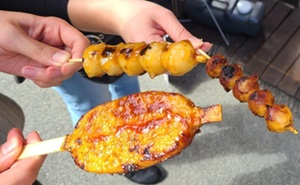
Skewers of Japanese dumpling become trash
Foreign tourists say that the towns in Japan are clean.
But they also say that there are few trash boxes in the town.
Japan has promoted reducing waste.
Separating and recycling the garbage are performed actively in each city and town.
The place where trash box is put tends to become a dirty garbage place including the surrounding areas.
So trash boxes have been decreased in many cities.
In addition, the reduction of trash boxes in the cities has been triggered by September 11 attacks struck at the United States of America in 2001.
It is one of continuous anti-terrorism activites in Japan.
Littering is a bad manner.
It is recommended that own trash is taken home and disposed there.
This is current Japanese society.
While travelling in Japan, you will create trash mainly when eating while walking in a town.
There are the recycle boxes for plastic bottle and can of drinks.
The package, small skewer, tray, etc. of the foods may be collected by the shop that you bought the foods.
You are required to dispose your trash properly in Japan.
It is an idea that you carry a bag for your trash during walking around the city and put the bag into a trash box in the city or in the room of your hotel after your walking.
Few places where Free Wi-Fi is available
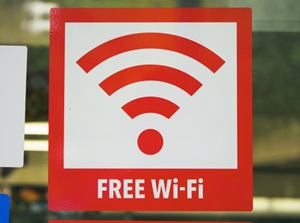
Sign of the place where Free Wi-Fi is available
Most Japanese people contract with a communication carrier for the mobile phone.
So, the demand for free Wi-Fi is not very great.
The places where free Wi-Fi is available are limited.
Airports, main railway stations, major hotels, popular chain cafes, major chain restaurants, many convenience stores are the main places.
But, it is not available outdoors.
It is true that many foreign tourists feel inconvenient.
But, from the above reasons, the places are declining.
Illness while travelling
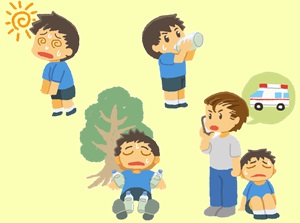
Heatstroke in summer is increasing
If you have a chronic disease and take some medicine, you should take the medicine on a travel.
Of course, the quantity must be for the period of the travel.
And the certificate of ingredients of the medicine may be needed when you are entering into Japan.
Unfortunately, if you have taken sick or gotten injured in Japan, you may need to consult a doctor.
In that case, you should go to a hospital.
You can search the hospital handling your languages.
When you must go to any hospital, please check the following websites.
If the condition is serious, call the ambulance.
The telephone number of ambulance is also "119".
Ambulance is in fire station, so you are asked "fire" or "ambulance".
You must tell the operator clearly "ambulance", your name, your place, condition of the patient.
It takes about 10 minutes (national average) for the ambulance to reach you.
In Japan, it is free to use ambulance.
If you have consulted a doctor, you must pay expensive cost of the treatment and medicines.
If you must stay in the hospital for some days, the cost will go up.
There are few hospitals that you can use credit card.
Most hospitals are operated on a cash only.
Just in case, you should take out any travel insurance before the travel to Japan.
Natural disaster while travelling
Japan is on the geographical position between huge Eurasian Continent and huge Pacific Ocean.
Various phenomena of weather in both land and sea occur, and two huge ocean plates and two huge continent plates are pressing against each other under the ground.
Therefore, various natural disasters often occur in Japan.
While travelling around Japan, there is a possibility that you will encounter the disaster.
Japan National Tourism Organization prepares the website about natural disaster for foreign tourist.
Heavy rainfall
From mid-June to mid-July every year, most areas of Japan are in rainy season named "Tsuyu".
It is cloudy or rainy most days during the peroid.
There is a similar rainy period from late September to early October.
Between both rainy seasons, there is midsummer season of Japan.
Recently, by global warming, the temperature in many areas is over 35 degrees Celsius for many days.
In such summer season in Japan, the days raining very heavily are increasing.
Even in midsummer, sudden heavy rain shower occurs locally and the town is flooded.
Japan belongs to the temperate zone, but Japan in summer may already be in subtropical area.
Because most areas in Japan is mountainous, some rivers rise and break the banks, and some landslides occur.
At that times, Shinkansen and railways around the area are often delayed or stopped.
And, the sections of the expressways are closed and the express buses are also stopped.
From July to September, you should check the weather forecast in Japan every day.
Heavy snowfall
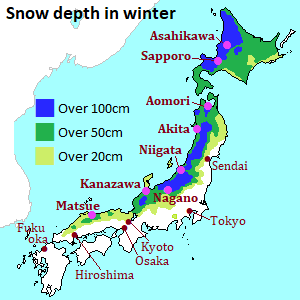
Japan is one of snowy countries in the world.
But the areas of heavy snowfall are along the Sea of Japan.
In winter, very cold northwesterly wind blows from Siberia in Russia and crosses over the Sea of Japan.
The wind absorbs much water vapor of the warm sea.
The cold and wet wind blows against the high mountains of Japan Islands.
At that time, much water vapor changes to snow and falls heavily in the land.
After that, the dried wind lost the water vapor blows down to the side of the Pacific Ocean.
So, it almost never snows in the areas such as Tokyo, Osaka, Kyoto, etc. and the weather is fine and dry.
The main season of heavy snow is January and February.
Ironically, it is also said that global waming leads to much snowfall.
The amount of snow depth may increase in future.
In very heavy snowfall and snowstorm, Shinkansen and main railways are often delayed or stopped.
Rather, deep snow on the road is troublesome, express buses are greatly affected.
When you travel around the snowy areas in winter, you should check the information of the snowfall.
Typhoon
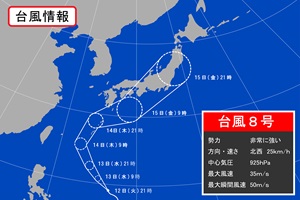
Image of predicted course of a typhoon in weather report
Typhoon is a developed tropical cyclone.
It is called "Taifû" (台風) in Japanese.
Typhoon is the same as "Hurricane" on the Atlantic Ocean and the East Pacific Ocean, "Cyclone" on the Indian Ocean and the South Pacific Ocean.
The central atmospheric pressure is very low, and strong wind blows into the center like a huge whirlpool.
The storming area with strong wind and rain is within a range of hundreds of kilometers in diameter.
Strictly speaking, Japanese "Taifû" includes strong tropical cyclone with weaker wind speed than typhoon from the point of view of disaster prevention.
Each typhoon is named according to the list of international registered names.
But, in Japan, the ordinal number in the year is given to "Taifû" including typhoon and it is used generally.
Over 20 Taifûs form every year.
But, many of them form in hot season from July to October.
Half of Taifûs approach Japan, and 3 to 5 Taifûs hit Japan every year.
Typical Taifû is born around north of the equator on the West Pacific Ocean, and it moves toward northwest first.
And it changes direction around far south of Japan, and moves toward northeast with the prevailing westerly winds.
Taifû around Japan moves at the speed of car.
So, in a place under the Taifû, strong warm wind blows and heavy rain falls from some hours to half a day.
But strong rain clouds out of the Taifû come in advance, so it often rains for a few days before.
In Japan, after a Taifû has formed, the course is predicted and is reported in the weather forecast on TV and web.
It takes 3 to 6 days to reach Japan.
The tourists travelling Japan should know the information every day.
When a Taifû approaches and passes Japan, the storm rises in wide areas.
So, there is a high possibility that all transportation are stopped on the day or in advance.
Various facilities may be also closed.
If you have encountered a Taifû, you will not be able to make a move until it leaves.
Earthquake & Tsunami
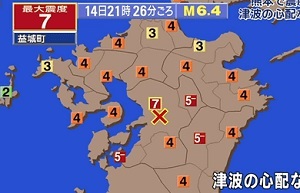
Report of great earthquake in Kyushu on TV
About 30 minutes after the earthquake, Apr.14, 2016
Earthquake is called "Jishin" (地震) in Japanese.
Japan is an earthquake nation.
In fact, some small earthquakes occur somewhere in Japan every day.
The earthquake that people feel the shaking occurs several times a month, and strong earthquake occurs every a few years.
It is said that about 10 percent of the earthquakes in the world occur around Japan.
Therefore, there is a possibility that you will encounter an earthquake in any place even during a trip in Japan.
Generally, the scale of earthquake is expressed in "Magnitude".
Over maginitude 7 (M7.0) earthquake is called "Great earthquake".
Magnitude is the scale of the eartquake itself.
In Japan, along with magnitude, the scale of the shake on each place is expressed in the rank 0 to 7 in terms of disaster prevention.
It is called "Shindo" (震度) and is "Seismic intensity scales" in English.
Each Shindo of many local areas is reported on TV and web within a few minutes.
| Rank | Condition | Damage |
|---|---|---|
| 0 | Imperceptible to people. | No |
| 1 | Felt by only some people in the building. | No |
| 2 | Felt by most people in the building. Some people awake. | No |
| 3 | Felt by most people in the building. Some people are frightened. | Rare |
| 4 | Many people are frightened. Some people try to escape from danger. Most sleeping people awake. | A little |
| 5- | Most people try to escape from a danger. Some people find it difficult to move. | Some |
| 5+ | Many people are considerably frightened and find it difficult to move. | Some |
| 6- | Difficult to keep standing. | Large |
| 6+ | Impossible to keep standing and to move without crawling. | Great |
| 7 | Thrown by the shaking and impossible to move at will. | Enormous |
Roughly speaking, Japanese people are used to earthquake.
In the shake under rank 2, we only feel the earthquake.
In the shake of rank 3 or 4, we brace ourselves keeping tension.
In the shake over rank 5-, we recognize large earthquake and worry about the damage.
And Japanese government establishes disaster headquarters.
But, there are few people who get into a panic.
Most foreign tourists will be surprised at the earthquake of rank 2 or 3.
Wait there until the quake stops with attention to falling objects.
You must not lose your cool.
If you have encountered a large earthquake and the town have suffered damage, you will become a victim of the earthquake.
You must wait for the means of transportation and the place to stay according to the local government and residents.
After a great earthquake, the aftershocks continue for the time being.
The earthquake victims are forced to spend anxious and inconvenient days.
Tsunami
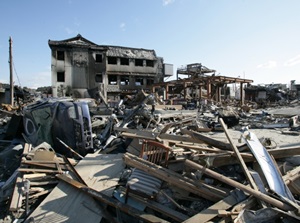
Yamada town in Iwate Prefecture destroyed by Tsunami of Great East Japan Earthquake
Tsunami (津波) is originally a Japanese word.
Japanese people have had damage from tsunami many times since ancient times.
When a great earthquake occurs under the sea, the bottom of sea moves suddenly because of great destruction of underground.
It causes huge waves on the surface of the sea and the waves spread in all directions.
This is Tsunami.
The wavelength is from several kilometers to several hundreds of kilometers.
So, tsunami has strong power and fast speed.
When the tsunami has reached the coast, the wave becomes higher and surges to the land.
The mass of water runs on the land without weakening the power and the speed.
The speed is faster than car and the wave catches up with running people.
The power destroys all buildings and houses in the wide areas along the coast easily, and the water with a large amount of rubble flows on the land.
Even the tsunami only 20 centimeters deep can wash your body away easily.
Now, when an earthquake occured, it is always reported on TV and web whether tsunami will come or not.
If you have encountered a large earthquake near the sea and the coast was warned against a tsunami, you must evacuate to high place far from the coast immediately.
Even upper floors of the reinforced-concrete building near the coast are not safe.
Alarm of large earthquake

Earthquake Early Warning displayed on smartphone
Earthquake is the waves traveling underground, and weak P-wave travels faster than strong S-wave.
So, in Japan, the system catching the P-wave and detecting the occurrence of large earthquake is in operation.
When it detects a large earthquake, the information is sent to broadcast stations and is broadcast with alarm tone on TV and radio in a moment.
The earthquakes over Shindo rank 4 or 5 are commonly caught.
The alarm can be set in the mobile phones by Japanese mobile network operators, so the users can catch the alarm anytime, anywhere.
Of course, strong quake by S-wave comes within a few seconds.
In the short interval, you must do any action to protect yourself.
In addition, Shinkansen trains also have the system.
When P-wave is detected, the electric power supply to running train is stopped and the train is stopped automatically and safely.
Great Earthquakes in Japan
Recent severe earthquakes of rank 7 around Japan are the following.
In the 21st century, the frequency of strong earthquake is increasing.
1995, Jan.17 : Around Kobe city (M7.2, Great Hanshin Awaji Earthquake)
2000, Oct.6 : Tottori (M7.3)
2004, Oct.23 : Niigata (M6.8)
2011, Mar.11 : Great East Japan Earthquake (M9.0) [earthquake and tsunami]
2016, Apr.14 & 16 : Kumamoto (M6.5 & M7.3)
2018, Sep.6 : Hokkaido (M6.7)
2024, Jan.1 : Noto Peninsula (M7.6) [earthquake and tsunami]
Great East Japan Earthquake in 2011
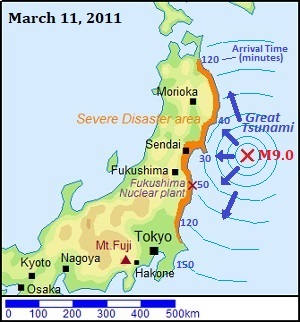
Great East Japan Earthquake
The Great East Japan Earthquake occurred at 14:46 on March 11, 2011.
The scale of the earthquake was M9.0, and it was one of the strongest earthquakes in the world since the 19th century.
And, the epicenter was the underground of the Pacific Ocean about 200 km east of Sendai city.
The previous earthquake of this huge scale at this place occured in 869. (Over 1,150 years ago)
The ranks of the strong quake in main cities were the followings.
Rank 7 = Kurihara city (in Miyagi Prefecture)
Rank 6+ = Sendai, Utsunomiya
Rank 6- = Koriyama, Mito, Narita
Rank 5+ = Fukushima, Morioka, Nikko, Tokyo
In Tokyo, the buildings were shaked greatly and all transportations stopped.
Over 3.5 million people could not return home, so many of them had to stay in Tokyo.
The function of a large city stopped for a while.
In addition, the rank was 4 even in Nagoya and Sapporo more than 600 km away from the epicenter, and the rank was 3 in Kyoto and Osaka more than 800 km away.
Great tsunami attacked the whole east coast of Honshu Island.
The tsunami reached faraway American continent.
The first wave reached the nearest coast 25 minutes after the earthquake.
The height was over 8 meters along many coasts, and a highest part was over 40 meters.
The number of dead or missing persons reached about 18,400, and over 90% of them are by the tsunami.
In addition, the tsunami hit Fukushima nuclear power plant and damaged the plant.
A large amount of radioactive material scattered in a wide area.
The decontamination operations of the areas around the plant had already finished, and the residents are returning there little by little.
Coming great earthquake
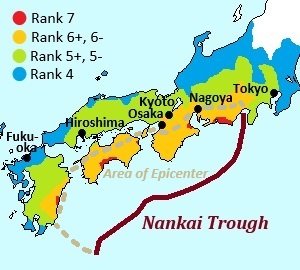
Predicted shindo by Nankai Trough Earthquake
Japanese people have worried about a huge earthquake for decades.
It is Nankai Trough Earthquake.
Nankai Trough is a oceanic trough over 4,000 meters deep and lies about 100 to 200 km off the western part of Japan.
The length is about 800 km.
The north side is a continent plate, and the south part is an ocean plate.
The ocean plate is pushing and sinking under the continent plate a few centimeters every year, so the power of the distortion is accumulating.
When the balance of power is broken, the whole plate slides and moves on a large scale and causes a huge earthquake.
That is the Nankai Trough Earthquake.
By Japanese ancient documents, the years of the earthquakes have been disclosed as follows and the great damages in wide areas were reported.
684, 887, 1096 & 1099, early 13th century, 1361, 1498, 1605, 1707, 1854, 1944 & 1946.
The intervals were about 90 to 150 years.
In a few cases, the great earthequakes occured in two parts within a short period.
When the earthquake occured in 1707, Mt.Fuji erupted 49 days later and much volcanic ash fell in Edo city (current central Tokyo).
The last earthquakes occured in 1944 and 1946.
It is thought that the former (M7.9) occured in the eastern part and the latter (M8.0) occured in the western part.
Just after both earthquakes, tsunami hit the wide areas of southern coast of Japan.
In 1943 and 1945, induced strong earthquakes about M7.0 had also occured around the areas.
The earthquake in 1944 was before the end of World War II, so the detailed information of the damage was hidden to keep it secret from the Allied Forces.
Now, about 80 years have passed since last great earthquakes.
It is assumed that the magnitude will be 8 to 9.
The strong quake will last for 2 to 3 minutes.
And, tsunami will attack the coasts in the areas facing Nankai Trough within a few minutes to a half hour.
It is assumed that the height of tsunami will be 10 to 35 meters.
In this area, there are most main cities such as Tokyo, Nagoya, Kyoto, Osaka, Hiroshima, so the area have a big population.
The damage will be enormous.
And, it is assumed that the tsunami about 1 to 2 meters will flow into the center of Osaka and Nagoya cities at the inner part of the bay.
Japanese government predicts that the probability of occurrence is around 80% within 30 years, 90% within 50 years.
But, no one knows when the earthquake will happen.
However, Nankai Trough Earthquake will certainly come.
All Japanese people recognize as a reality and are forming the mental attitude.
When you visit western and central Japan, you must keep this fact in mind.

